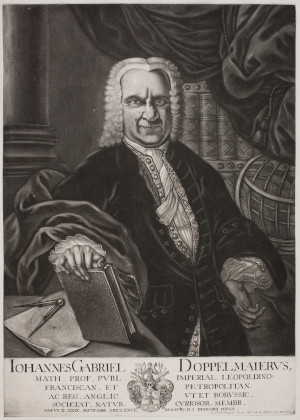

Johann Gabriel Doppelmayr (also spelled Doppelmair, Doppelmaier or Doppelmayer) was the son of the Nuremberg merchant Johann Siegmund Doppelmayr (1641-1686) and was born on 29 September 1677 (many early sources incorrectly give his year of birth as 1671). His father had an interest in applied physics and was one of the first to design a vertical vacuum air pump in Nuremberg.
Doppelmayr enrolled at the Ägidiengymnasium in 1689 and after completing his studies in 1696 enrolled at the nearby university of Altdorf to study law which he completed in 1698 with a dissertation on the Sun. He then attended lectures on mathematics and natural philosophy by Johann Christoph Sturm (1635-1703) which he completed in 1699 with his dissertation De visionis sensu nobilissimo, ex camerae obscurae tenebris illustrato. He continued his studies on physics and mathematics at the university of Halle where he also learned French and Italian.
In September 1700, Doppelmayr travelled to Berlin and from there, through Lower Saxony, to Holland where he visited Franeker and Amsterdam on his way to Utrecht where he stayed for a couple of months to continue his studies on physics and mathematics and to master the English language.
In April 1701, Doppelmayr went to Leiden where he stayed in the house of the astronomy professor Lothar Zumbach von Koesfeld (1661-1727) and learned (probably in the Musschenbroek workshop) how to grind and figure telescope lenses. He then travelled to Rotterdam and in May to England where he visited Oxford and London.
After returning to Holland in the end of 1701, Doppelmayr spent another five months in Leiden, where he followed astronomy lessons from Lothar Zumbach von Koesfeld. After visiting Utrecht, Deventer, Osnabrück, Hannover, Kassel, Marburg, Gießen, Wetzlar and Frankfurt, Doppelmayr returned to Nuremberg in August 1702 and was appointed professor of mathematics at the Ägidiengymnasium in 1704, a position that he would hold until his death.
In February 1716, Doppelmayr married Susanna Maria Kellner (1697-1728) with who he had four children (three of whom died shortly after their birth).
In 1723, he received an invitation to become the professor of mechanics at the Academy of St. Petersburg, but Doppelmayr declined and suggested that they should ask the Swiss mathematician Nikolaus Bernouilli for this position.
Doppelmayr wrote on astronomy, geography, cartography, spherical trigonometry, sundials and mathematical instruments. He often collaborated with the cartographer Johann Baptist Homann (1664-1724), a former Dominican monk from Oberkammlach in Schwabia who in 1688 had settled in Nuremberg and became a map engraver for the publishing firms of Jacob von Sandrart (1630-1708) and David Funck (1642-1709). In 1702, Homann founded an influential cartographic publishing firm that after his death was continued by his son Johann Christoph Homann (1703-1730) and after the latter’s death by his friend Johann Michael Franz (1700-1761) and his stepsister’s husband Johann Georg Ebersberger (1695-1760) under the name “Homännische Erben”. The publishing firm remained in business under different names until 1848.
Among Doppelmayr’s many students was Georg Friedrich Brander (1713-1783) from Regensburg, who settled in Augsburg in 1734 and in 1737 founded a renowned workshop for scientific instruments.
Doppelmayr was elected as a member of several scientific societies, including the Berlin Academy of Sciences, the Kaiserlich Leopoldinische Akademie der Naturforscher in Halle (1715), the Royal Society of London (on 6 December 1733, not in 1713 as mentioned in several sources) and the St. Petersburg Academy of Sciences (1740).
Doppelmayr died on 1 December 1750 in Nuremberg, and many later sources claim that his death was caused by the fatal effects of a powerful electrical shock which he had received shortly before while experimenting with a battery of electric capacitors. Other sources, however, suggest that Doppelmayr’s electrical experiments were performed several years earlier and were not the cause of his death.
The lunar crater Doppelmayer (latitude 28.5° south and longitude 41.4° west), the nearby rille Rimae Doppelmayer (latitude 25.9° south and longitude 45.1° west) and the minor planet 12622 Doppelmayr are named in his honour.
Doppelmayr was responsible for the edition and translation of several important works in astronomy, geography and scientific instrument making.
Together with Johann Georg Puschner (1680-1749), a Nuremberg instrument maker and copper plate engraver, Doppelmayr published terrestrial and celestial globe pairs in 1728 (32 cm diameter), 1730 (20 cm diameter) and 1736 (10 cm diameter). The celestial globes were drawn for the epoch 1731.0, the same epoch which he used for the celestial charts in the Atlas Coelestis (plates 16-25).
These globes were re-issued in the 1750’s by Puschner’s son and, again, in the 1790’s, when the copper plates passed into the hands of the Nuremberg publisher Wolfgang Paul Jenig (1743-1805). Although the terrestrial globes were updated in these later re-issues, the celestial globes were left unchanged.